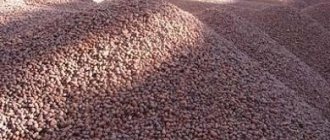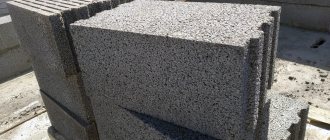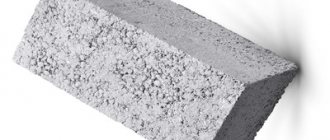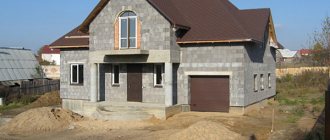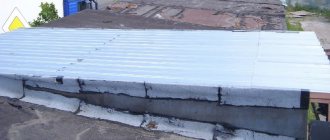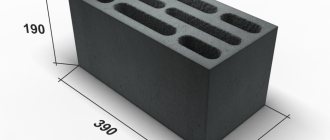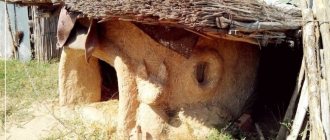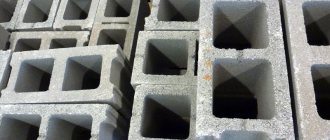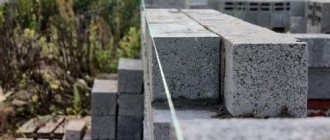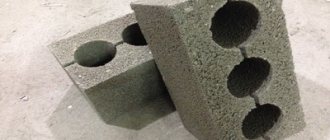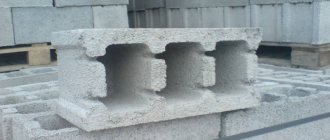Expanded clay gravel is a universal decorative and construction material that is used for the design of summer cottages and gardens, as well as in construction. Insulation is used everywhere today, making it possible to build a warm and energy-efficient home. Expanded clay is produced by firing clay in blast furnaces at a temperature of 1300°C. The material has high heat-saving and sound-insulating properties, which allows it to be used in lightweight concrete, as well as as backfill for building structures.
Description
Expanded clay grain is a mass that is covered with a porous shell. Depending on all the characteristics that the grain has, you can determine the quality of expanded clay gravel. It comes in 3 sizes: 5-10 mm, 10-20 and 20-30 mm. Based on these indicators, expanded clay gravel is divided into three fractions, and grains whose sizes are less than 5 mm are called expanded clay sand.
At first it may seem that expanded clay is not widely used, but it has high thermal insulation properties, making it an excellent heat insulator. This valuable property allows it to be used in insulating floors, interfloor ceilings, roofs and attics. Expanded clay gravel is not much inferior to popular building materials: brick or cement.
Thermal insulation is the main thing, but far from the only important property that a warm and comfortable home should have. Sound insulation, for example, is also an important aspect during its construction. Expanded clay gravel will be an excellent and inexpensive sound insulator, and can also be used as an “underlying” element of a concrete screed.
Where and for what is expanded clay used?
Expanded clay gravel has the following characteristics:
- Used in the manufacture of concrete;
- Resistant to various weather conditions - extreme heat and frost;
- It has fire-resistant, sound- and heat-insulating characteristics;
- Not susceptible to future rot.
All these properties are used in filling the foundation when building a house. This makes it possible to reduce the depth of the foundation by almost half. The latter will help you not only save on building materials, but also avoid freezing of nearby soils.
Expanded clay gravel is widely used in the construction of both modern baths and classic ones - Russian or Turkish. If you use expanded clay as a thermal insulation material for the walls of a bathhouse, you can easily achieve the required temperature, and then maintain it without any problems.
The scope of expanded clay is quite extensive and is not limited to construction. With its help, it is quite possible to lay out excellent paths on a summer cottage, speed up and increase the yield of fruit trees, creating an artificial drainage system for the roots. The same method is suitable for indoor and house plants, but you will have to use expanded clay of a finer fraction.
General properties of the material, its structure and types
Expanded clay is produced from clay by high-temperature firing, carried out at specialized enterprises. The outer surface of clay conglomerates is melted, which ensures its smoothness and specific color. The formation of a porous structure occurs due to gases released during firing.
Clay, in various forms, is found in most important building materials - brick, cement and a number of others. Its natural properties are characterized by high strength parameters, which expanded clay is not without. Despite the porous structure, which improves thermal insulation properties, its compression resistance is sufficient for use in concrete, expanded clay blocks and conventional backfill.
Depending on the shape, appearance and technological production process, expanded clay is divided into the following types:
- Expanded clay gravel - classic oval, almost round pellets or granules with a red-brown surface color - the main form of produced expanded clay. Such gravel is used throughout the construction industry;
- expanded clay crushed stone - represents fragments of large expanded clay conglomerates obtained by splitting the latter. The shape of the crushed stone is angular and has sharp edges. Primary use is limited to addition to concrete;
- Expanded clay screenings or sand are small particles that are a by-product of firing or crushing expanded clay and are used as a porous filler.
Gravel and crushed stone range in size from 5 to 40 mm, and expanded clay sand has particles smaller than 5 mm. Small crushed fractions of expanded clay are used in water purification (filtration) systems, and also as bedding in terrariums and aquariums. Such use is one of the evidence of low toxic qualities, allowing expanded clay to be given a “5” for environmental friendliness.
The appearance of the material is very unpresentable, but this does not matter. Expanded clay is almost never used in open form, but is part of concrete or insulated wooden and concrete floors. The cost of expanded clay is the lowest among available thermal insulation and structural materials, for which it deservedly receives a “5” rating.
The picture shows a photo, a general description of expanded clay and its features
Leveling the floor using expanded clay, dry screed
Using expanded clay, you can quickly and naturally high-quality level the floor, while ensuring high thermal insulation. The whole process is quite simple, but you can consider the process of filling (pouring) the floor with your own hands step by step:
- First, the base is cleaned and primed, after which a floor with favorable conditions for leveling is obtained.
- A waterproofing layer should be provided, which is formed from polyethylene film using beacon profiles.
- Expanded clay gravel should be poured into the resulting strips, which should be from different fractions to make it easier to compact it.
- The thickness of the expanded clay layer is determined by the master himself, but, as a rule, the layer should be at least 5 cm. If gravel is used on the lower floors of a multi-story building, then the layer can reach 10-15 cm.
- Then all the gravel strips are filled with cement.
To fill expanded clay, cement laitance is used, which is necessary in order to get rid of the gaps between the granules. Of course, expanded clay concrete is much stronger and more reliable than expanded clay and cement separately, but using milk has its own strengths.
To properly pour expanded clay and cement laitance, it is necessary to lay the masonry mesh on the compacted expanded clay, and then fill it with a non-liquid solution. As a result, you will receive a reinforced mesh covered with a cement crust.
The video shows in detail how to calculate the amount of expanded clay needed, how to simplify the work, and also how to pour a reinforcing primary floor screed:
Pros and cons of expanded clay
Expanded clay, a porous substance with low weight, is lighter than mineral wool and other foamed polymers, but it is durable. Its weight suggests insulation of the ceilings, since there is no significant load on the ceiling.
At the same time, insulating floors followed by cement screed makes the process easier, since during work you can walk on the material without fear for its integrity. The main advantages of expanded clay lie in the following:
- high level of noise and heat insulation. The porous structure resists the propagation of sound waves, and as insulation, the granules work like a thermos;
- low volumetric weight;
- environmental friendliness;
- high resistance to mechanical stress, no rodents are afraid of it;
- expanded clay is completely safe for humans, no larvae grow in it;
- fire-resistant material that does not ignite;
- resistance to negative temperatures, frost resistance of at least 25 cycles;
- has durability, is not prone to rotting, does not form mold or fungi;
- neutral to chemicals;
- simple installation, can be done by one person without construction skills;
- low cost;
- does not decompose over time;
- widely used in growing domestic plants. Expanded clay prevents moisture evaporation, providing control of water balance;
- a popular substrate among gardeners.
With all its advantages, it is worth noting that expanded clay has some disadvantages:
- absorbs water easily, but dries poorly. Because the melted, brown crust is a ceramic coating that prevents drying. Perhaps this is not bad for hydroponics, but it is unacceptable for material - insulation;
- as insulation, it is recommended to fill in expanded clay, without further cement screed;
- good thermal insulation requires a lot of material; the backfill layer must be at least 500 mm.
Expanded clay in landscape design
Expanded clay is widely used not only in construction, but also in landscape design, as well as for decorative purposes. Expanded clay can be painted in various colors, so it acquires the properties of a decorative material.
With its help, you can decorate a nearby area of trees or shrubs by applying gravel in the form of colored soil. Decorating your summer cottage can be combined with marble or granite, then the end result will look more attractive. Painted expanded clay is an aesthetically beautiful and environmentally friendly material.
Expanded clay of a large fraction makes an excellent landscape path. However, using expanded clay in its pure form is unprofitable, since the service life of such a path will be limited to several years. It is better to mix it into cement mortar or fill it as a filler under other coatings.
In the photo, expanded clay paths as an element of garden decor
Scope of expanded clay
Due to its low cost and attractive properties, expanded clay is a very popular construction and heat-insulating filler. The material does not require specific skills to work with, it is lightweight, inexpensive, and accessible, which is why its scope of application is unusually wide and varied:
- production of facing and high-hollow ceramic bricks;
- production of expanded clay concrete blocks,
- insulation of floors, walls, attic floors, resulting in a reduction in heat loss by 70%;
- use as a porous aggregate in the production of lightweight concrete.
- everywhere in the construction complex: residential buildings, industrial buildings, country houses and much more, where this inexpensive material is in demand.
- as design solutions in the local area - various paving slabs, bulk structures;
- in agriculture, the water balance indicator stabilizes after the inclusion of expanded clay grains in the soil;
- in wastewater treatment plants, participates in rough cleaning using filters;
Houses built from expanded clay blocks back in the days of the Soviet Union still safely accommodate thousands of families throughout Russia and beyond for more than half a century. In addition to the fact that they have good strength and retain heat well, our climate is also conducive to the use of this frost-resistant and not capricious building material.
Many people remember these structures as “people's construction projects”. In general, it is worth noting that concrete or blocks made with the addition of expanded clay have high strength characteristics and remain light despite their large dimensions.
Roof slope
When arranging the roofs of any buildings and outbuildings, at least a minimum roof slope is required. This is explained by the fact that a perfectly smooth and flat roof is ineffective from the point of view of drainage: on such a roof, the water remaining after precipitation can lead to its damage and leakage.
The device for pitching the roof using thermal insulation materials is a very economical and simple process. The most appropriate for the slope-forming layer is the use of light textured expanded clay, which does not require additional reinforcement of the roof. The final slabs are laid on inclined compartments with expanded clay, after which they are fastened together using special parts.
The use of expanded clay for floor insulation
The sequence of insulation of all types of floors has the same algorithm.
- free the surface from the old coating;
- Seal cracks and cracks with mortar;
- Flooring can be installed directly on an earthen base. First compact the earth, make a cushion of sand and pour gravel.
- Expanded clay must be insulated from moisture with a layer of waterproofing, using, for example, Izospan D.
- pour expanded clay onto the isospan film. Advice from experienced builders says that insulation requires a good layer. It is advisable to form a layer of at least 10 cm.
- Next we lay out the reinforced mesh
- We perform the screed with cement mortar.
- We lay out a vapor barrier - isospan C, then lay a new floor.
If you are insulating the ceiling, then it is better to use expanded clay of two fractions as part of the “pillow”. This technique will allow you to create a denser backfill, which more effectively retains heat in the living space.
In the recent past, it was problematic to buy expanded clay for private use, since it was sold in bulk and in large volumes. It was extremely inconvenient to buy an expanded clay machine, with little need.
Nowadays, everything is much simpler and manufacturers pack their goods in bags of different volumes. You can buy expanded clay in packaging in the required quantity without overpaying for extra supplies. The packaging makes transportation easier and will not raise any serious questions.
Mortar for cement screed with expanded clay and its proportions
Before you start leveling the floor, you need to mix expanded clay and DSP. In its composition, this mixture is close to expanded clay concrete or plain concrete. We recommend the following ratios when preparing expanded clay concrete:
- 20-25 bags of expanded clay of various fractions;
- 12-15 bags of sand concrete (M150, M300);
Deviations of proportions in different directions will bring different results. Thus, increasing the concrete in the solution will increase strength and reliability, as well as thermal conductivity.
How is expanded clay made?
The parent of expanded clay, as we have already noticed, is a special clay rock. The essence of the process is based on the well-known property of clay - to swell when heated. Special pyrogenic ovens, similar to drums, which rotate in a circle at a certain angle, are used in the preparation of expanded clay.
Raw granules are fired to obtain a certain structure. Clay balls at an angle rush towards the burning torch.
Having received a heat shock of about 1200 degrees, the clay composition boils and swells. On the outside, the material melts and turns brown. Then comes one of the most important steps: cooling. The process consists of several stages. Surely builders know that there is such a term as “soil swelling coefficient”; it is this principle that is incorporated into the magical process of transforming clay mass into expanded clay. The firing itself lasts about 45 minutes.
Insulation
Expanded clay is a highly effective insulation material that is used to insulate wooden and concrete floors, ceilings, walls, floors, roofs and attics. Thanks to its high thermal insulation properties, expanded clay has gained wide popularity not only in home insulation, but also in bath construction or laying foundations.
In addition, it is widely used for insulating loggias and attic floors. The thickness of the backfill layer for roof insulation depends on climatic conditions, external covering, ceiling height and expanded clay fraction.
The following video will tell you about the features of expanded clay insulation:
Disadvantages - individual parameters
The advantages of expanded clay (good strength, low thermal conductivity) are practically not affected by its individual disadvantages. Unlike numerous heat insulators, the disadvantages of expanded clay are very limited.
These include the following:
- increased tendency to dust formation, which is especially noticeable when working indoors. A respirator, which should always be at hand at a construction site, helps solve the problem;
- long-term drying of wet material - how hard expanded clay absorbs moisture, so difficult it is to get rid of it later. To prevent high humidity in rooms containing expanded clay, reliable moisture and vapor protection should be provided in advance.
Minor shortcomings, combined with high performance indicators, allow us to rate the practicality of expanded clay at 4 points.
The main properties and characteristics of expanded clay gravel, as well as its pros and cons, largely depend on the production technology and the correctness of the stages of its implementation.
Advantages and disadvantages of expanded clay
Many people who use expanded clay to insulate their homes are satisfied. After all, this building material has high thermal insulation qualities and is also not expensive at all.
Strengths:
- Excellent thermal conductivity;
- Light weight (convenient for transportation, as well as for installation);
- Environmental cleanliness;
- Low cost compared to similar insulation materials;
- Based on these advantages, expanded clay can undoubtedly be rated 5 points.
- The disadvantages are:
- The need to use a thick layer of expanded clay, otherwise it will not be enough for proper heat and sound insulation;
- It is very susceptible to moisture, so it is necessary to either use polyethylene or waterproofing film.
Table of expanded clay fractions used and their features for the construction of various structures
| Design | Fraction, mm | Water content,% mass | Thermal conductivity, W/mK |
| Roof | 10-20 | 0,5 | 0,09 |
| Interfloor ceilings | 4-10 | 0,5 | 0,11 |
| Floors in contact with the ground | 10-20 | 6 | 0,12 |
| Geotechnical | 10-20 | 30 | 0,19 |
The disadvantages of expanded clay are quite insignificant and are fully covered by its advantages.
Due to the fact that expanded clay has an excellent pricing policy, it is very convenient and practical to use. The appearance is extremely attractive and is widely used in decoration. The material is environmentally friendly and harmless; in addition, expanded clay has a fairly simple production process. Based on this, we can give this building material a rating of 4.5 points.
Expanded clay - properties, characteristics
- long service life;
- fireproof;
- weatherproof;
- lasting;
- does not emit odor;
- frost-resistant;
- environmentally friendly;
- low thermal conductivity;
- high bulk density;
- a light weight;
- waterproof.
How is expanded clay made?
Its derivative raw materials are a certain type of low-melting clay, environmentally friendly, without impurities or additives.
Expanded clay is made by firing clay in ovens at high pressure and elevated temperatures. Therefore, to the question - what is expanded clay, you can answer that it is processed clay.
During the production process, the clay boils and becomes bubbles - granules. The outer shell begins to melt, creating a smooth, even surface. If we carefully cut it in half, we will see that inside each granule has a porous structure. The output is granules of various diameters, which are then sorted and stored according to size. The price and scope of application will depend on the size.
Use of expanded clay in construction
- Thermal insulation of floors, ceilings, attics, basements;
- Thermal insulation of strip foundations and blind areas of houses;
- Thermal insulation of flat roofs, creating a slope on the roof;
- Production of expanded clay concrete blocks and lightweight concrete;
- Thermal insulation of soil - lawns and drainage on the site;
- Thermal insulation of communications; in case of repairs, expanded clay is reused;
- Hydroponics, expanded clay creates an optimal microclimate for plant roots.
When laying expanded clay, it should be protected from getting wet and absorbing moisture with a waterproofing film (polyethylene, roofing felt, etc.).
As you can see, the scope of application of this insulation in construction and in the home is diverse, which can be explained by the excellent thermal conductivity, environmental safety and strength of the insulation. In addition, the material is free-flowing and takes any shape; it can be used to fill any media. When used correctly, it can reduce heat loss in the room by 50-75%.
